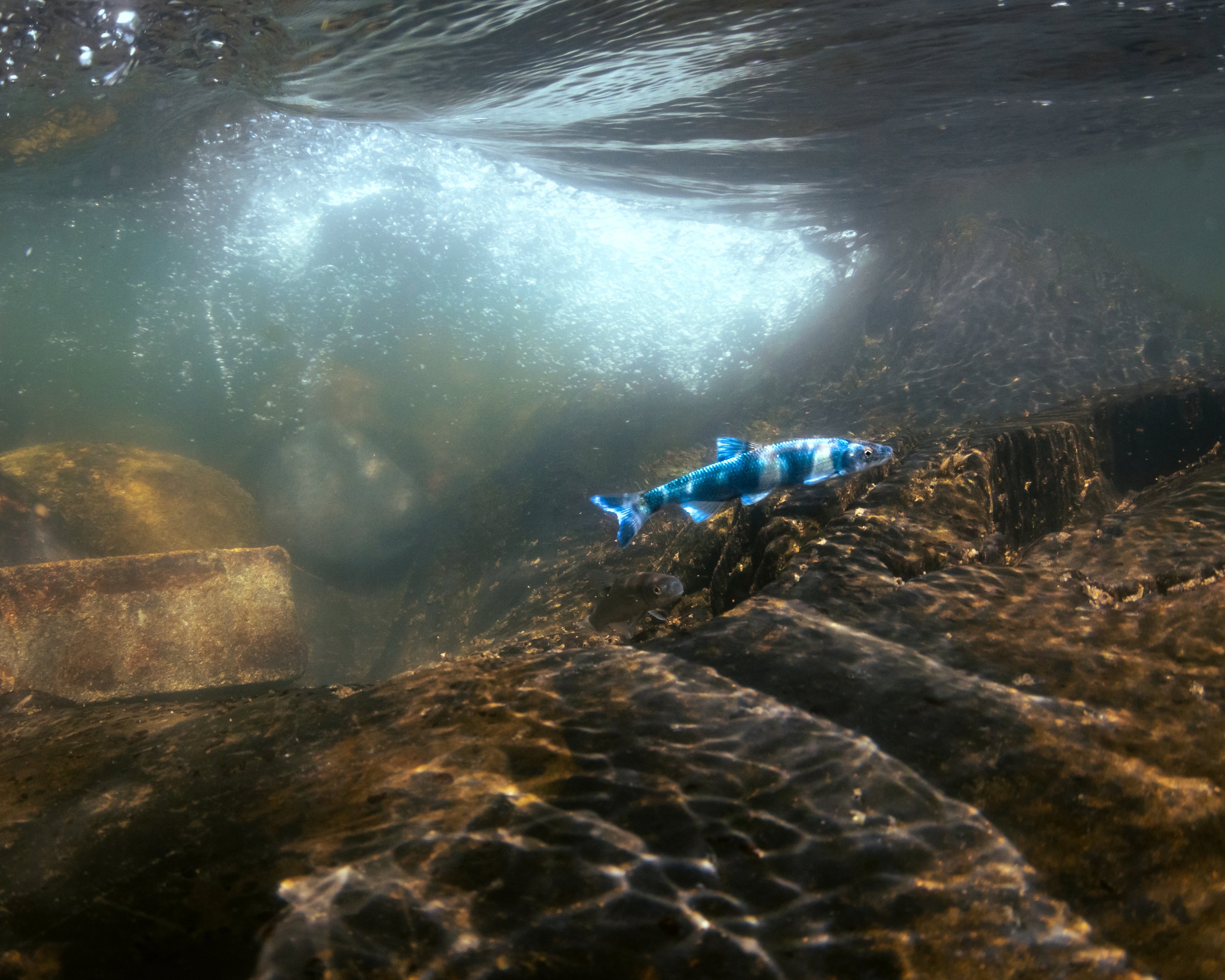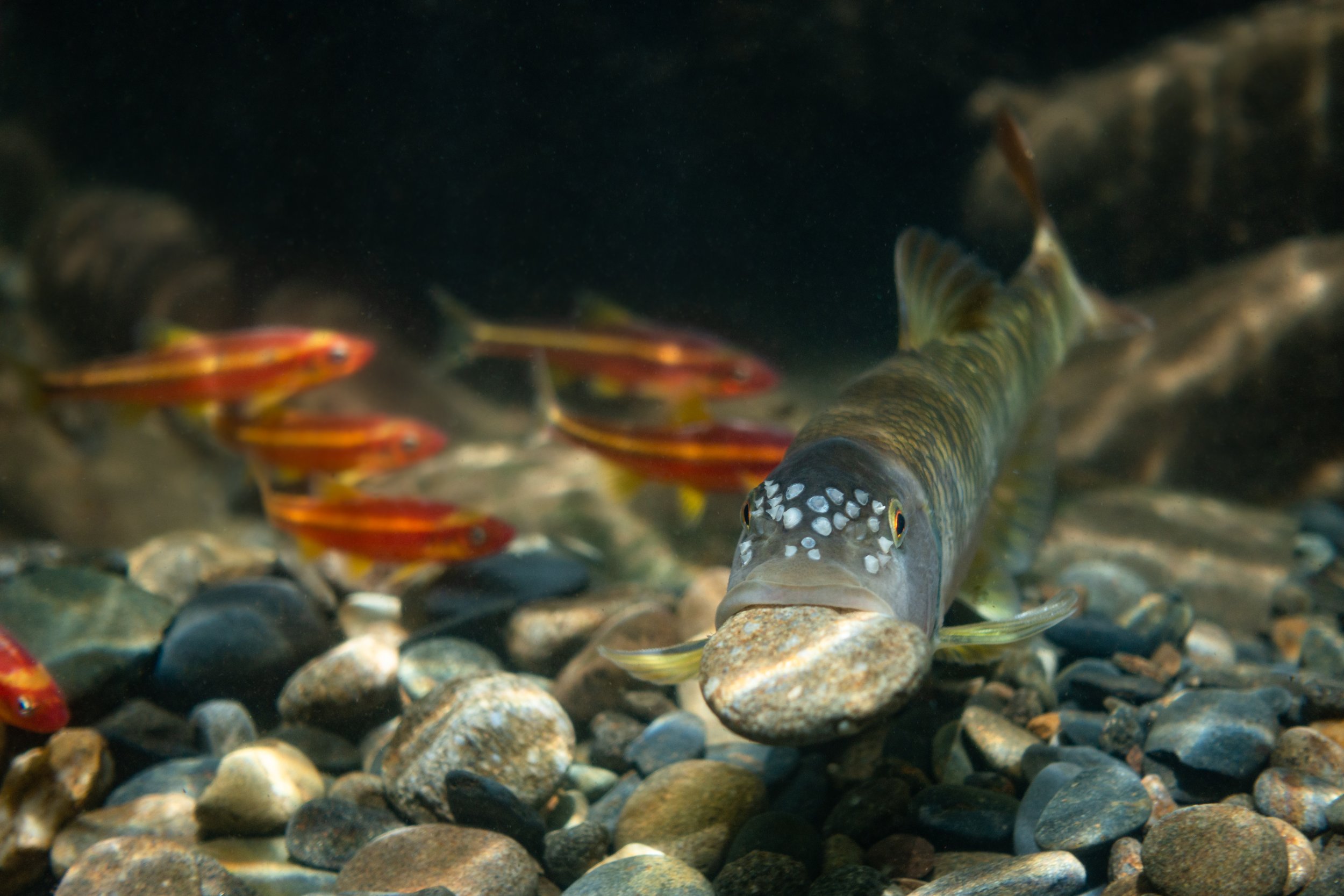
Making a Difference
Explore some of our successes from the last 35+ years.
-
The Problem: In 1957, Abrams Creek was poisoned with rotenone in favor of a planned introduced trophy trout stream in conjunction with the completion of Chilhowee Dam. This inundated the lower reaches of Abrams Creek and the Little Tennessee River. The rotenone was intended to eliminate the “rough fish” that were then thought to compete with the trout, but ended up killing off several native, non-game species in the process.
Our Solution: Smoky Madtom and Yellowfin Madtom life histories were studied by Peggy Shute and Gerry Dinkins after discovering them in Citico Creek, allowing Conservation Fisheries to develop propagation protocols in an effort to breed these species and restore their populations in Abrams Creek. The Citico Darter was later discovered in Citico Creek and was hypothesized to have also been native to Abrams Creek.
Conservation Fisheries has been propagating or rearing Smoky Madtoms and Yellowfin Madtoms since our establishment in 1986, and rearing Citico Darters since 1993. Today, Abrams Creek holds healthy populations of all three species and no longer needs to be stocked. Instead, we do genetic transfers of a few fish per species between Abrams Creek and Citico Creek to promote healthy, genetically diverse populations in both waterways.
-
The Problem: The Barrens Topminnow, indigenous to the Barrens Plateau of Tennessee, co-evolved with the bison that once wandered our grasslands. They relied on the grazing disturbance of passing herds to keep the canopy surrounding the stream short enough to encourage sunlight to reach the creek bottom. This sunlight is necessary for the growth of native algaes which the Barrens Topminnow lays its eggs in. As the bison were driven off the landscape and eventually replaced with more modern agricultural practices, stream quality degraded. Livestock were either fenced out of the stream, causing the surrounding vegetation to become too dense to allow proper light transmission, or they were allowed constant, concentrated access to the waterway, creating pollution and increased erosion. More recently, the introduction of Western Mosquito Fish, an invasive species much more tolerant of these harsh conditions, has driven the Barrens Topminnow even closer to the edge of extinction.
Our Solution: We are propagating and holding assurance colonies of four genetically distinct populations of Barrens Topminnows in partnership with Dale Hollow National Fish Hatchery and Wolf Creek National Fish Hatchery. Other assurance colonies are being held at the Tennessee Aquarium Conservation Institute. The species will likely go extinct in the wild in our lifetimes without more well-managed, publicly owned sites for reintroduction.
-
The Problem: Shoal Creek in Middle Tennessee, a part of the small native range of the Boulder Darter, had suffered severe declines in fishes diversity due to heavy pollution from city sewage and toxic heavy metals from a lawnmower manufacturing plant.
Our Solution: We have been propagating Boulder Darters since 2005 to restore the Shoal Creek population. Our propagation efforts have restored hundreds of juvenile Boulder Darters each year into Shoal Creek, though consistent monitoring has proven difficult due to high flow rates and low visibility. We have only released fish in Tennessee, but when we have been able to monitor, we have observed Boulder Darters south into Alabama!
Additionally, in the Elk River, before it was discovered that Boulder Darters have pelagic larvae (unbeknownst to most, who would assume that a benthic fish has benthic larvae), the Tennessee Valley Authority was using their electric turbine from late May to early October which was macerating the free-swimming larvae.
It was during our earliest years working with this species that we discovered their pelagic larval stage, which influenced the Tennessee Valley Authority to change their turbine schedule so as not to negatively impact the pelagic larvae in the Elk River during and after the Boulder Darter spawning season.
-
The Problem: There are historic records of Spotfin Chubs from the Little Tennessee River in East Tennessee, but the fish were absent from several major tributaries following pollution. logging, and the resulting sedimentation that occurred following settlement of the region. Even as water conditions improved towards the turn of the millennium, Spotfin Chubs were unable to return to their historic habitats due to isolation from the reach of the river impounded by the Fontana Dam.
Our Solution: We have been restoring Spotfin Chubs into Tellico River, one of the aforementioned tributaries of the Little Tennessee River, since 2002. Although the river continues to face challenges from decades of abuse, we are encouraged by regular sightings of wild-reproducing fish.
The Cheoah River is not somewhere with a historic record of Spotfin Chubs, but it made a good candidate for introductions. It had previously been dewatered and dried up due to a flume bypass that led water to the Cheoah Dam, leaving an empty niche with no native fish or predators in the waterway and very few fine sediments. These conditions made the Cheoah River a good location to establish a backup population. The lack of long-accumulated sediments left many clean, open crevices for the fish to lay their eggs. and warm water coming from Santeetlah Lake. Spotfin Chub introductions truly gave life back to this river.
-
The Problem: In 2008, the already imperiled Duskytail Darter was split into 4 genetically distinct species, each of which were now remarkably more rare. This included the Marbled Darter, whose historic range is unknown due to a lack of records. It did have one remaining population in the Little River. Although the waterway was heavily polluted in the early 1900s due to deforestation and agricultural practices, today it is one of the most biodiverse streams in East Tennessee.
Our Solution: We propagated this species using breeders from their existing population with the intent to expand their current range upstream. Our augmentation efforts expanded the Marbled Darter’s range 2.5 river miles upstream of its known range at the time and the species persists there to this day. A second round of attempts were made to expand the range even further upstream, but, for unknown reasons, they failed to become established.
-
The Problem: The Buck Darter was once widespread throughout the Buck Creek System, but declined to a single tributary system in recent years.
Our Solution: Following several years of rearing and propagation, we have successfully restored them to a second tributary in the system. Future plans, in partnership with the USFWS and the state of Kentucky, include attempting to restore other areas of the Buck Creek system.
-
The Problem: Many North American species of mussels have a complex life cycle involving fish as an intermediate host for the larval mussel, known as glochidia. These glochidia attach to the gills, fins, and skin of fishes before they drop off and mature. Mussels have developed symbiotic relationships with specific species of fish in order for this life stage to take place. The rarest of them are often only able to use a single species of fish to rear their young. As water quality declined following the industrialization of North America, mussel populations plummeted, leaving them as one of the most imperiled groups of organisms in the country and in desperate need of captive propagation efforts.
Our Solution: We have propagated several species of fish to be used as mussel hosts for rare, often federally-protected mussels. Propagating fish as mussel hosts reduces the need for collection, which may strain wild fish populations. Additionally, wild fish develop an immune response to fight glochidia attachment, which may be why captively propagated (and immunologically naive) fish serve as markedly better hosts.
As of September 2022, we have sent 12,605 fish to mussel hatcheries to be used as mussel hosts. Species include Greenside Darters, Redline Darters, Whitetail Shiners, Common Logperch, Banded Sculpin, and Blotched Chubs.
-
As of April 2022, we’ve sent 20,263 fish to other institutions for various research projects including life history, toxicity studies, and work aimed at bettering our ability to track fishes in the wild.
Several of the species we’ve worked with have allowed us, through observation, to better understand the life histories of non-game fish. Without these observations it would be difficult to understand the behaviors and life cycles of several species of rare fish. Using surrogate species in a similar way also helps us to understand the life histories of more common species which are closely related to critically imperiled fishes. This allows us to learn from and develop protocols well before taking in a species that we may have few chances to work with. This work can also inform management decisions in the field. Some surrogate species we have worked with include Crystal Darters as a surrogate for Diamond Darters and Warrior Darters for Vermillion Darters.
Toxicity studies are often performed on species that are sensitive to changes in water quality. We will propagate these fish to send to other institutions for lab-based research, which eliminates the need for wild fish to be collected for these studies. Pygmy Sculpin are an example of a species propagated for toxicity tests. This research can inform governing bodies on how to manage potential threats to wild populations.
Although PIT (Passive Integrated Transponders) tags, a kind of GPS recorder, are a popular method for tracking larger animals, they are simply too cumbersome for many of our non-game species. For these smaller animals, we use VIE (Visible Implant Elastomer) tags to mark animals in specific locations and with specific colors before release to allow us to recognize animals when recaptured. To study the effects and longevity of these tags, we will mark common species and observe them in the hatchery or send these propagated fish to other institutions to perform further research. Blueside Darters are an example of a fish we propagated to monitor tag retention.
-
The Problem: Kentucky Arrow Darters have historically had scattered populations in the Kentucky River drainage, but many populations have declined or disappeared due poor water quality from sedimentation and mining practices.
Our Solution: Along with the Kentucky Department of Fish and Wildlife Resources, we attempted a restoration in Long Fork, a tributary to Hector Branch. This restoration proved to be successful when we observed stocked fish that had reproduced and dispersed into Hector Branch.
-
The Problem: The Cumberland Darters’ range has been restricted to public lands with intact forests, which protect the streams in which the species lives. Monitoring done by the state of Kentucky and the U.S. Fish and Wildlife Service found that they were present in a stream called Indian Creek, but were absent from its tributary Cogur Fork.
Our Solution: Our restoration efforts and subsequent monitoring have shown that our efforts have restored the population in Cogur Fork.
Not sure what these terms mean?
Check our our glossary.


